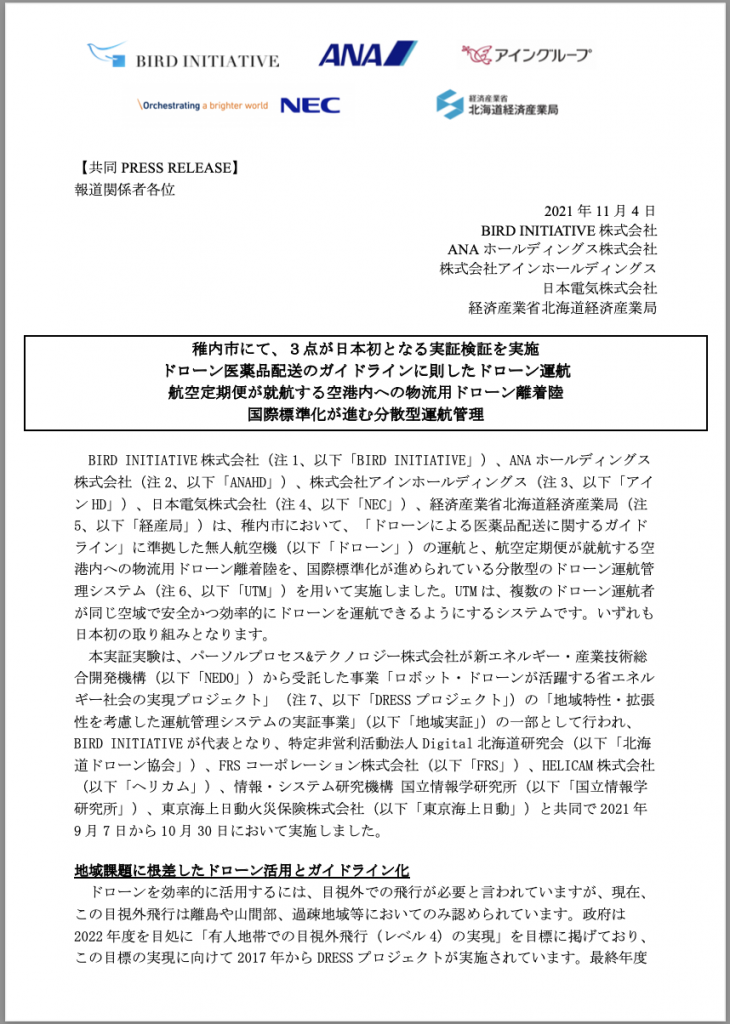; ?>/img/splash-2@sm.png)
In Wakkanai City, three points were verified for the first time in Japan.
・Drone operation in accordance with guidelines for drone pharmaceutical delivery
・Logistics drone takeoff and landing at airports where scheduled airline flights operate
・Distributed flight management with increasing international standardization
BIRD INITIATIVE Co., Ltd.(Note 1, hereinafter 「BIRD INITIATIVE」) 、ANA Holdings Co., Ltd.(Note 2, hereinafter「ANAHD」) 、Ain Holdings Co., Ltd.(Note 3, hereinafter 「Ein HD」),NEC(Note 4, hereinafter 「NEC」) 、Ministry of Economy, Trade and Industry, Hokkaido Bureau of Economy, Trade and Industry(Note 5, hereinafter referred to as the "Keizai Bureau") operates unmanned aerial vehicles (hereinafter referred to as "drones") in compliance with the "Guidelines for Pharmaceutical Delivery by Drones" in Wakkanai City, and within airports where scheduled airline flights operate. Logistics drone takeoffs and landings were carried out using a distributed drone operation management system (Note 6, hereinafter referred to as "UTM"), which is currently being standardized internationally. UTM is a system that allows multiple drone operators to safely and efficiently operate drones in the same airspace. Both of these initiatives are the first of their kind in Japan.
This demonstration experiment was carried out by Persol Process & Technology Co., Ltd. under a project commissioned by the New Energy and Industrial Technology Development Organization (NEDO) to create an energy-saving society in which robots and drones play an active role (Note 7, hereinafter referred to as DRESS The project was conducted as part of the ``Demonstration Project for a Traffic Management System Considering Regional Characteristics and Scalability'' (hereinafter referred to as ``Regional Demonstration'') of the Digital Hokkaido Study Group, a specified non-profit organization, and BIRD INITIATIVE was the representative. (hereinafter referred to as "Hokkaido Drone Association"), FRS Corporation Co., Ltd. (hereinafter referred to as "FRS"), HELICAM Corporation (hereinafter referred to as "Helicam"), National Institute of Informatics, Research Organization of Information Systems (hereinafter referred to as "National Institute of Informatics"), This event was conducted jointly with Tokio Marine & Nichido Fire Insurance Co., Ltd. (hereinafter referred to as "Tokio Marine & Nichido") from September 7 to October 30, 2021.
Drone utilization and guidelines rooted in local issues
It is said that to utilize drones efficiently, it is necessary to fly beyond the visual line of sight, but currently, this beyond-visual-line-of-sight flight is only permitted on remote islands, mountainous areas, depopulated areas, etc. The government has set a goal of ``achieving beyond visual line of sight (Level 4) flight in manned areas'' by 2022, and the DRESS project has been implemented since 2017 to achieve this goal.
This year, the final year of the program, drone demonstrations are being carried out in use cases rooted in local issues in each region to verify the UTM currently under research and development in various parts of Japan. This time, when conducting the demonstration in Wakkanai City, we classified use cases from the perspective of maturity and verified use cases in different phases. Verified use cases include monitoring of marine mammals (seals, etc.) in the phase of verifying ideas for solving regional issues, monitoring of poaching in the phase of turning verified ideas into guidelines, and use cases that are recognized as a legal system but have unclear operational implications. Some points need to be clarified regarding airport takeoff and landing, and pharmaceutical delivery, which is in the phase of improving guidelines.
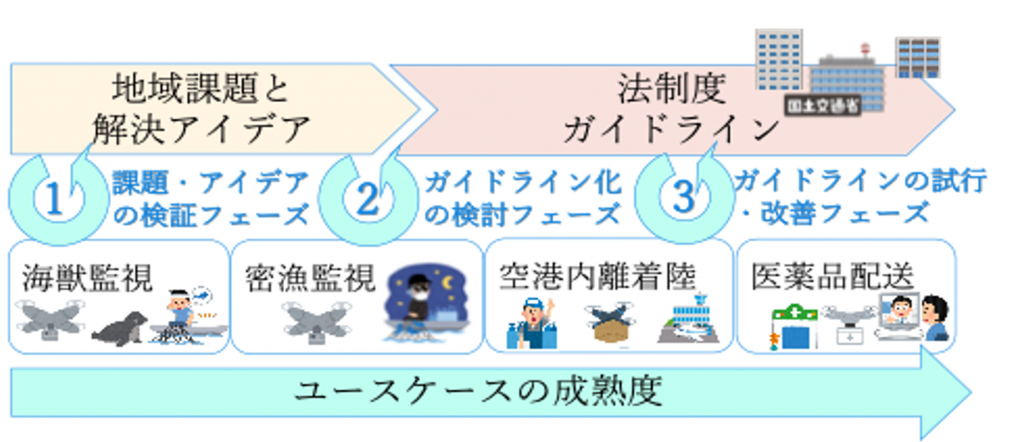
Classification of drone utilization use cases from a guideline perspective
Drone operation in accordance with guidelines for drone pharmaceutical delivery
In June 2021, the Cabinet Secretariat, the Ministry of Health, Labor and Welfare, and the Ministry of Land, Infrastructure, Transport, and Tourism established the ``Guidelines for Pharmaceutical Delivery by Drone'' (Note 8). Pharmaceutical delivery by drone has been attracting attention from the perspective of providing medical care in remote areas. After receiving online medical treatment and online medication guidance, patients can receive their medicines via courier service, but there have been issues such as delivery times taking several days in remote areas.
This time, AIN HD, ANAHD, and the Hokkaido Bureau of Economy, Trade, and Industry conducted Japan's first demonstration experiment based on these guidelines. After the patient received online medical treatment from Wakkanai Municipal Hospital, AIN HD dispensed medicines and provided online medication guidance, and ANAHD conducted a demonstration experiment in which the medicines were delivered to the patient by drone. In addition, the newly established guidelines state that measures such as locking containers should be taken to prevent packages from being opened by third parties other than the destination, and Toppan Forms Co., Ltd. We are provided with lightweight and lockable containers.
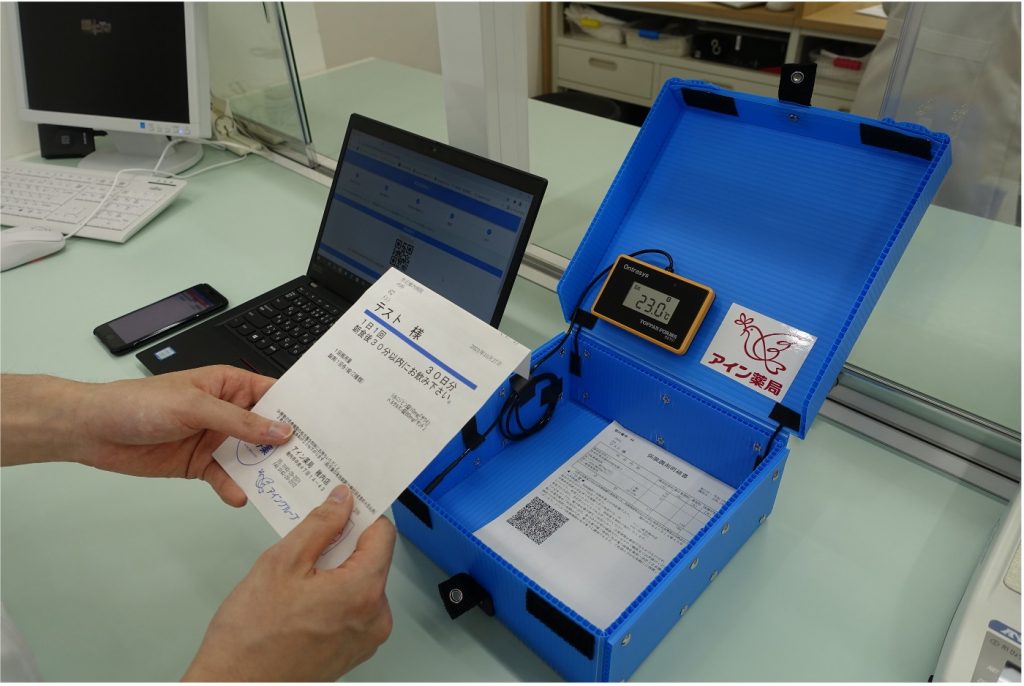
Delivery tracking system and lockable containers
Logistics drone takeoff and landing at airports where scheduled airline flights operate
In cooperation with Hokkaido Airports Co., Ltd. (abbreviated as "HAP"), ANAHD conducted Japan's first demonstration experiment in which logistics drones were flown, taken off, and landed at an airport with regular airline service. In this demonstration experiment, a logistics drone took off and landed at Wakkanai Airport and flew inside and outside the Wakkanai Airport premises, to verify the connection between drone logistics and air logistics. These connections will enable rapid and consistent transportation from rural areas to urban areas and are expected to create a new hub-and-spoke logistics network centered around airports and promote industry in rural areas in the future. Masu.
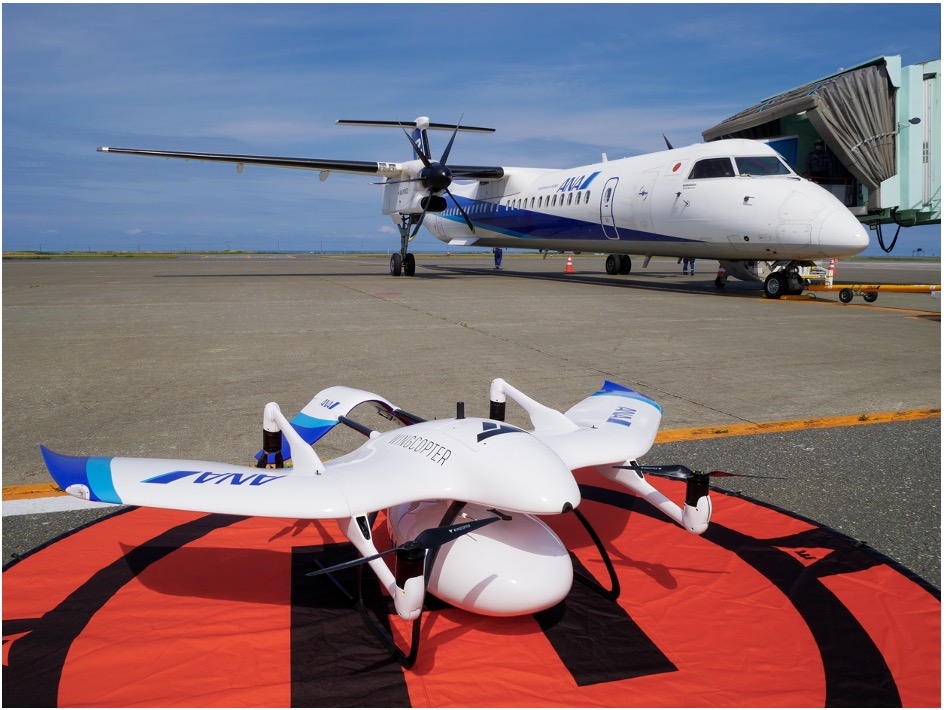
Connecting drone logistics and air logistics
Technical verification and operational system verification for monitoring poaching outside of nighttime visual range
Poaching occurs not only in Hokkaido but all over Japan, causing serious economic damage to the fishing industry, and is an important social problem. There have already been cases of poaching monitoring using drones, and demonstration experiments are being conducted in various places. This demonstration was conducted by Helicam, which operates the drone, in cooperation with the Wakkanai Fisheries Association, Wakkanai Police Station, and Hokkaido Drone Association.
In the experiment, the drone was equipped with a thermal infrared camera to detect poachers, a loudspeaker to deter poaching, and a spotlight and zoom camera to arrest poachers, and various technical verifications were conducted at night outside of visual range. For operators entrusted by the police and others to operate the aircraft while ensuring their safety, it is desirable to operate the aircraft from a remote location out of the visual line of sight. In this verification, we also considered and verified the cooperative structure and operation among the fisheries cooperative, police, city, and ship operator.

Zoom image taken from an altitude where flight sounds are difficult to hear
Ascertaining the number of seals from the sky
Fixed net fishing is popular around Wakkanai City, but the problem of seals and sea lions getting into these fixed nets and devouring the fish has become a serious problem. Although extermination efforts are being carried out by hunters, the number of animals can only be determined visually from land, and comprehensive management is not possible. Therefore, in this demonstration experiment, FRS operated a drone in cooperation with the Hokkaido Drone Association to assess the number of animals. In addition to seals resting on the coast, we also assessed the status of seals swimming around fixed nets.
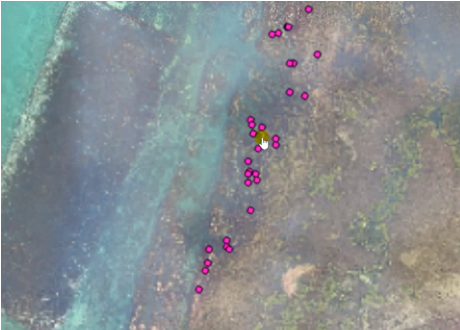
Ascertaining the number of seals
Decentralized flight management is becoming increasingly standardized internationally
In the DRESS project's UTM, a civilian flight operations management system (UASSP) is connected to a centralized flight management integrated function (FIMS), and all flight plan information and dynamic information are aggregated in the FIMS, thereby eliminating conflicts between flight plans. Approval/denial of flight applications will be managed to ensure that there are no mistakes. In this demonstration, BIRD INITIATIVE operated the UASSP. Furthermore, in addition to this centralized operation management, we operated multiple UASSPs and interconnected them in order to verify the decentralized operation management that is becoming increasingly standardized in Europe and the United States.
This attempt is the first in Japan. In decentralized flight management, each UASSP autonomously determines whether or not to proceed with a flight plan, and to do so, detects and resolves the necessary duplication of flight plans in a decentralized manner. This verification was conducted in cooperation with ANRA TECHNOLOGIES, which is leading international standardization (Note 9). Additionally, Tokio Marine & Nichido conducted an analysis of the risks associated with flying drones using UTM.
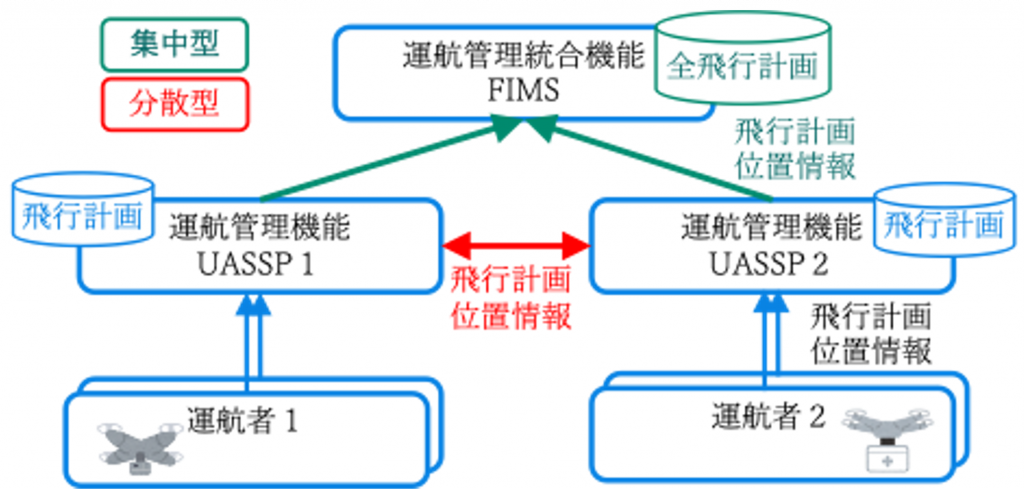
Verification of centralized and decentralized flight management
Building a digital twin for distributed flight management and verifying autonomous route adjustment technology
An important feature of decentralized flight management is the ability for operators to automatically draw up, negotiate, and coordinate flight plans that can be agreed upon with other operators. Therefore, in collaboration with the National Institute of Informatics, NEC recreated Wakkanai City in a simulation space and developed and verified autonomous route adjustment between marine mammal monitoring and logistics. NEC also collaborated with the National Institute of Advanced Industrial Science and Technology to develop logistics coordination technology that simultaneously assigns logistics tasks and plans routes.
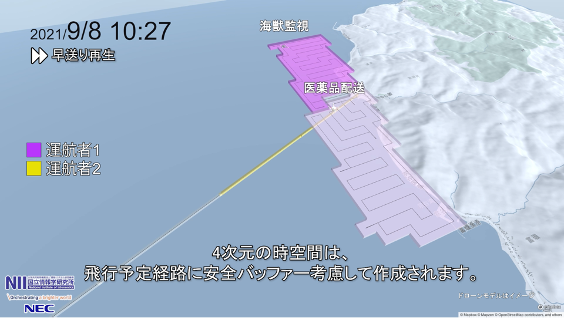
Autonomous route coordination between marine mammal monitoring and logistics operators
Coordination of flight plans between drone and medical helicopter
ANAHD, NEC, and the National Institute of Informatics will utilize FORSER-GA, a manned helicopter flight management system provided by Weathernews Inc., to detect and eliminate duplication of flight plans through flight management services assuming a manned aircraft flight environment. We have verified the following. Coordinating flight plans with other aircraft during operation is necessary not only between drones but also with manned aircraft such as medical helicopters, so we verified route adjustment in simulation space.
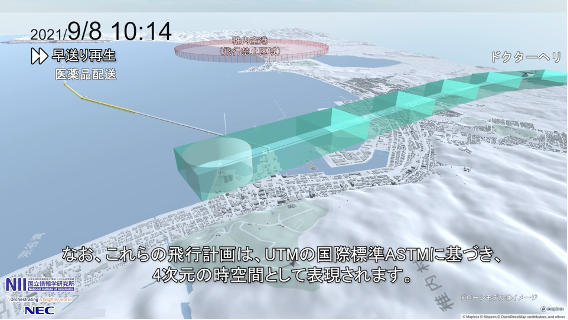
Route adjustment with a helicopter in simulation space
In the future, we aim to contribute to the realization of beyond visual line of sight flight (Level 4) in manned areas by making recommendations based on the verification results of this demonstration for reflection in guidelines.
that's all
(Note 1) BIRD INITIATIVE Co., Ltd. Headquarters: Chuo-ku, Tokyo, Representative Director, President and CEO: Masamitsu Kitase
(Note 2) ANA Holdings Co., Ltd. Headquarters: Minato-ku, Tokyo, Representative Director and President: Shinya Katanozaka
(Note 3) Ein Holdings Co., Ltd. Head office: Sapporo, Hokkaido, President and CEO: Kiichi Otani
(Note 4) NEC Corporation Headquarters: Minato-ku, Tokyo, Representative Director, Executive Officer, President and CEO: Takayuki Morita
(Note 5) Ministry of Economy, Trade and Industry, Hokkaido Bureau of Economy, Trade and Industry, Location: Sapporo City, Hokkaido, Director: Shigetoshi Ikeyama
(Note 6) UTM (UAS Traffic Management) is a system of systems that manages the operation of UAS (Unmanned Aircraft System, drones), and DRESS provides operation services to UAS Operators (UASOs). An architecture is being considered in which the flight management subsystem (UASSP: UAS Service Provider) is centrally managed by the flight information management system (FIMS). In the United States, an architecture is being considered in which USS (UAS Service Suppliers), which correspond to UASSPs, connect to each other in a decentralized manner. In Europe, decentralized cooperation through USP (U-Space Service Provider) is also being considered, mainly in Switzerland.
(Note 7) A project to realize an energy-saving society where robots and drones play an active role
Drones and Robots for Ecologically Sustainable Societies project (DRESS project)
(Note 8) “Guidelines for drug delivery by drone”
https://www.kantei.go.jp/jp/singi/kogatamujinki/kanminkyougi_dai16/betten3.pdf
(Note 9) ASTM International
PR TIMES Press release:https://prtimes.jp
NEDO regional demonstration_joint press release.pdf:
